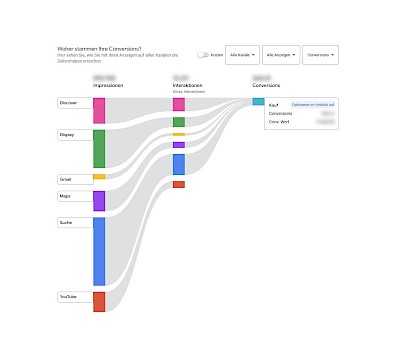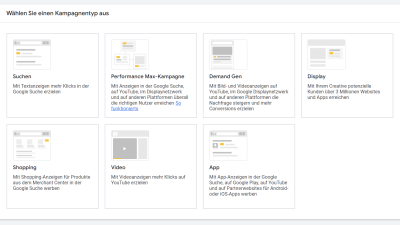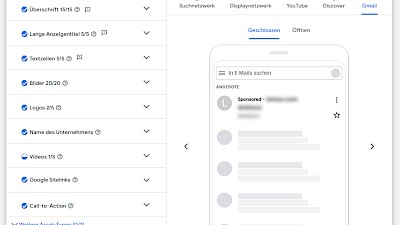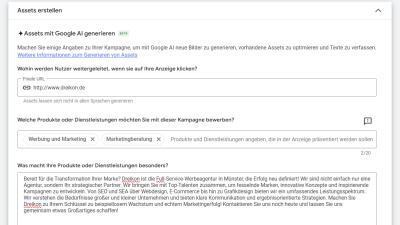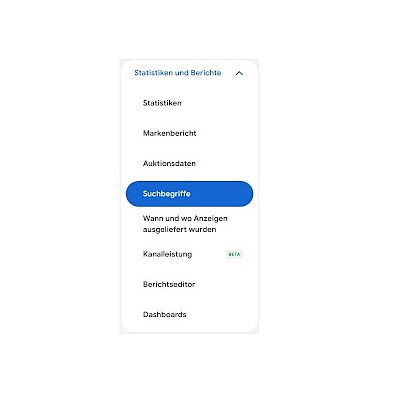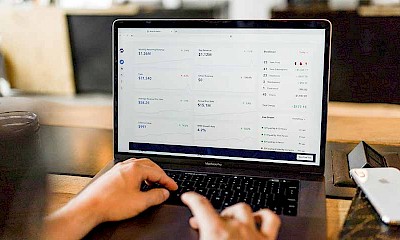
Performance Max campaigns - the all-in-one campaign in Google Ads
What the automated campaign type currently means for your Google Ads strategy
Performance Max campaigns bundle all Google advertising networks into a single format: Search, Display, YouTube, Shopping as well as Discover, Gmail and Maps. The basis is fully AI-supported automation.
The new features of 2025 give advertisers more transparency and control: Performance Max offers new functions such as campaign-level negative keywords, detailed search reports and extended channel reports. Standard Shopping campaigns are also fully usable again and access the same inventory as Performance Max.
For advertisers, this creates a new field of tension between comprehensive automation and targeted control.
The most important facts about Performance Max campaigns in a nutshell:
- All-in-one campaign format - combines search campaigns, YouTube campaigns, shopping campaigns, display campaigns and more in a single campaign.
- Automated target achievement - AI controls bids, budget allocation and ad setup.
- Flexible use of assets – Images, videos, headlines, long ad titles, text lines and logos are automatically combined by the system.
- Target groups & signals – search topics, interests, demographic characteristics, or existing target groups serve as a starting point, which Google expands using AI.
- Optimization through machine learning – Performance Max campaigns continuously learn and scale successful combinations.
- Centralized success measurement – Clear reports on conversions, budget, ROAS, and channels.
- Ideal for extensive campaigns – saves time and integrates channel synergies.
What are Performance Max campaigns?
Performance Max is a fully automated campaign type that controls playout across all relevant Google channels. Based on the assets you provide (images, videos, texts and others) and the target specifications, the algorithm independently controls the combination and playout in order to optimize conversions across multiple channels.
The advantage over traditional shopping campaigns:
- PMax uses the multichannel reach to also address users in the awareness or consideration funnel who would otherwise not be reached in the shopping search result.
- The result is a holistic user experience across various touchpoints.
What's new in Performance Max campaigns in 2025
- Equality in shopping inventory: Since 2025, standard shopping campaigns have had the same full access to product ads as Performance Max.
- Search exclusions: Cross-campaign exclusion of unwanted keywords and brands at account or campaign level, as well as via negative keyword lists.
- Page feeds & URL grouping: Targeted control of traffic to specific landing pages within the campaign.
- Improved asset management: Video assets can now be created and reviewed directly in the campaign setup.
- Enhanced transparency: Asset group performance reports and channel reports show in detail how conversions and budget are distributed.
- Testing options: Comparison of PMax and manual campaigns to measure actual conversion increases.

Performance Max campaigns: Who they are suitable for
According to the name Performance Max, the campaign type is designed to deliver maximum performance. If you want to use Google Ads to generate leads, increase your brand awareness, boost your sales or increase traffic to your website, Performance Max campaigns are for you. Performance Max campaigns are designed to bring you to the attention of as many potential customers as possible and ultimately get you more calls, more visits to your store, website or online store. As with any other Google Ads campaign, you can specify in advance whether your campaign should pursue one of these marketing objectives or several business objectives.


How does Performance Max work?
Instead of creating ad groups, Google Ads users only need to store assets in the form of creatives and provide more detailed information about the target group to set up the campaign. The Google AI combines assets such as text ads, display banners or video formats according to format and learns from their performance. Through machine learning, Google recognizes which combinations achieve the best ad performance and prioritizes them. This data-driven approach ensures that the campaign is continuously optimized and adapts to changes in user behaviour.
In contrast to other campaign types, Performance Max does not display ads to predefined target groups for specific keywords, but evaluates user signals to calculate the probability of a conversion for specific users. This means that ads are displayed based on user behavior instead of keywords.
How to create Performance Max campaigns?
Selecting the target project
First select the target project for your campaign as usual. In order to create a Performance Max campaign, you must select Leads, Sales, Website traffic, Local store visits, Promotions and/or Campaign without advertising as the campaign objective.
Defining the daily budget
As usual, you can enter your average budget per day in the campaign. Depending on user signals, the budget per day can sometimes be exceeded and sometimes fallen short of. At the end of the month, however, you will always reach your defined budget.
Selecting the desired bidding strategy
Even if the bid management is completely taken over by Google and cannot be set individually, you can at least specify in advance which bid strategy should be pursued. In principle, Performance Max campaigns only pursue smart bidding strategies.
You can determine in advance whether the focus should be on increasing conversions with target costs and therefore with a target cost-per-acquisition (target CPA) or on maximizing the conversion value with or without setting the target return on advertising spend (target ROAS). If you select the maximize conversion value bidding strategy, you also have the option of activating the customer acquisition option. This allows you to adjust the bids in a targeted manner in order to acquire more new customers.
Location & language
The right location settings, language selection, and advertising schedule are also crucial for PMax. Do you want to reach users from a specific catchment area only? Are your services or products only suitable for people who speak a certain language? Is your company closed on certain days and does not need to run ads on those days? Provide this information to Google.
Assets instead of ad groups
While you are used to grouping ads with the same objective in an ad group in Google Ads, Performance Max campaigns now allow you to divide a campaign thematically into asset groups. There you can upload text, images including company logos, videos, ad titles, and calls to action, which are the building blocks of each ad. PMax then automatically creates the respective ad formats from these. A minimum number of different assets is required for automated ad placement. In our infographic, you can see how many assets you need to run a Performance Max campaign, the maximum number you can upload, and the formats they must be in. Another new feature is the ability to have assets automatically generated or optimized using Google AI, based on your landing page and selected.
Ad extensions
Would you like to offer your potential customers additional information such as a sitelink or call extension? You can configure these settings in the ad extensions.
Set user signals
To begin with, you can set signals to include users with whom you have already interacted and define relevant search topics, interests and detailed demographic characteristics. The target group targeting is then automatically adopted by Google. The specified user signals serve as a starting point, which Google expands using machine learning to reach people outside the defined target group.
Page feeds
With a page feed, you can define which URLs should be used in ads for your Performance Max campaigns. Creating a page feed for your most important landing pages helps Google Ads to better index these pages and make more targeted decisions about when to deliver your ads and which landing page to redirect users to.
Brand and keyword exclusions
Advertisers can now specifically exclude both brand-related terms and unwanted search queries. In addition to brand exclusions, search term exclusions and, in some cases, negative keyword lists are also available - for more control, less wastage and greater efficiency.
Shopping feed
A current product feed in the Google Merchant Center is required for Shopping ads within Performance Max campaigns. It contains the title, description, price, availability, images and the final URL. Google uses this data to display targeted ads in Shopping results and on other channels. An optimized and regularly updated feed significantly increases visibility and click-through rates, as it provides Google's AI with structured product information and thus increases relevance and conversion opportunities.
Infographic: Google Performance Max Assets
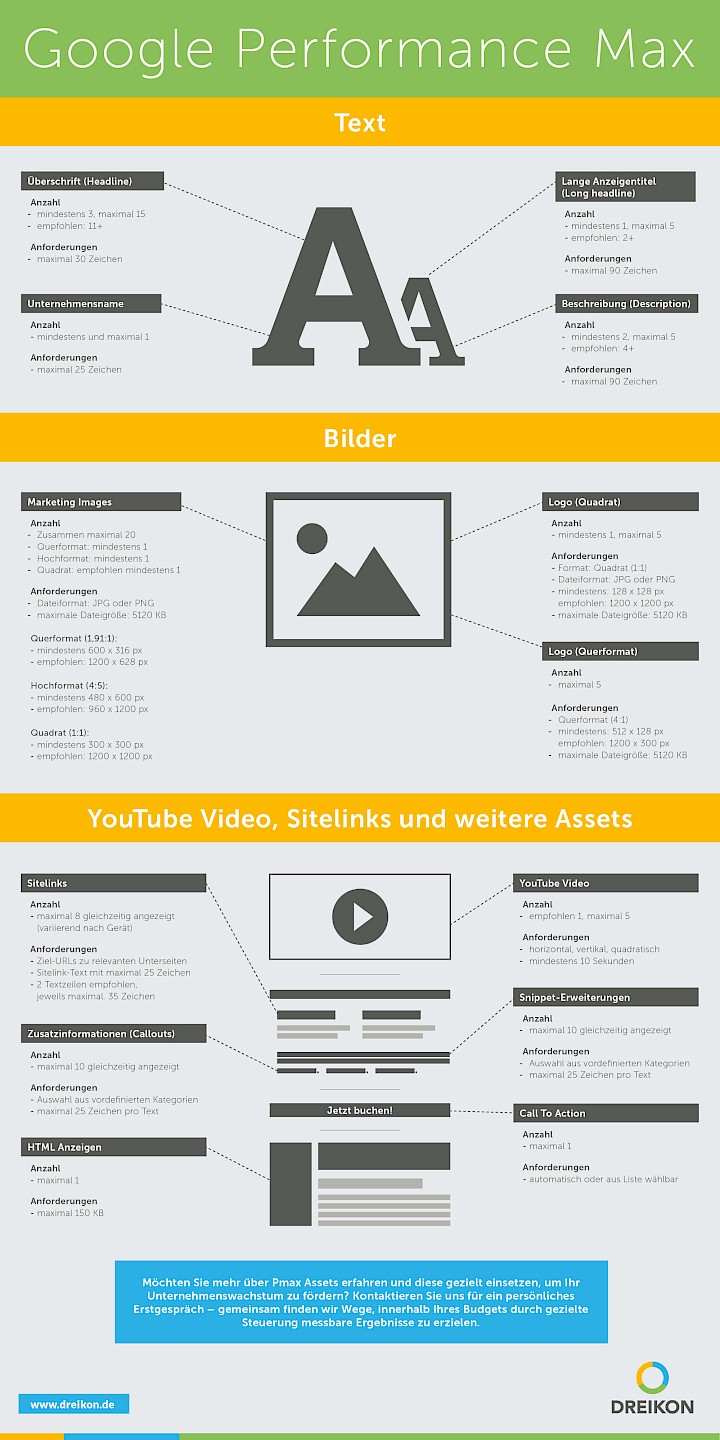
Advantages of Performance Max campaigns
Simple campaign creation
Anyone who struggles with setting up a campaign can breathe a sigh of relief. Because PMax takes care of a large part of it. All you have to do is upload representative and diverse creatives that Google uses for the automatic campaign setup. Beforehand, you define your objectives and then you can sit back and relax.
Save time
Performance Max campaigns are not only easy to use, they also save time in terms of maintenance. This is because PMax not only takes care of campaign creation, but also automatically takes care of optimization. Leave it to Google to react to changes in the market and other external factors and concentrate on your day-to-day business. Whereas you previously had to create separate campaigns for each channel, you now only have to create a single campaign that virtually manages itself.
Increase your reach
In addition to displaying ads in the entire Google advertising network, automatic targeting also allows you to increase your reach even further. Even more people who are likely to convert are addressed, who may not be taken into account with classic targeting.
Simple video creation
Since September 2022, Google's video editor has made it possible to quickly and easily create videos based on uploaded assets. With the help of topic-specific templates, you can create appealing video ads in just a few clicks and add music or recorded voiceovers if desired. The advantage over automatic creation is that the videos can be easily adapted to your corporate identity. This tool was fully integrated into the workflow at the beginning of 2023 and can be found directly via the asset library or when setting up Performance Max campaigns.
Search term exclusion
A significant advance in Performance Max campaigns in 2025 is the new option to evaluate and specifically exclude search terms directly in the campaign settings - without having to forego the benefits of fully automated campaign management. With this function, advertisers can actively remove unwanted, irrelevant or non-performing search queries in order to minimize wastage and increase the efficiency of their campaigns in a targeted manner. It is now also possible to use negative keyword lists. However, this function has not yet been rolled out in all accounts and is therefore only available to a limited extent.
Disadvantages of Performance Max campaigns
Automated creation / optimization: loss of control
The automation functions during campaign setup mean that you hand over full control to Google Ads. You have little opportunity to make settings or optimizations yourself.
Automatic video creation
If you do not upload your own videos in the assets, Google Ads automatically creates a video based on your uploaded assets. If you do not have a video, simply use Google's video editor to turn this disadvantage into an advantage.
All assets must be compatible with each other
As Google Ads creates all ads based on the assets you have uploaded, you have no influence over which assets are combined with each other. To ensure that your ads work well in terms of both content and appearance, all assets must be compatible with each other.
Transparency without control
Although Google now provides more insights into the individual channels (e.g. search network, YouTube, Display, Gmail, Discovery) for Performance Max campaigns - currently still in the beta phase - channel-specific control remains limited. Control is still only indirect - via the assets provided, target group signals and the campaign structure.

Tips for getting started with Performance Max campaigns
- If your product portfolio allows, create several asset groups with a thematic connection so that Google can place as many different ads as possible.
- Let your campaigns run for at least 6 weeks to complete the learning phase and get a representative impression.
- Use Performance Max campaigns in addition to and not exclusively to stabilize campaign performance through a manual campaign.
- Regularly maintain your keyword and brand term exclusions to exclude irrelevant or inefficient search queries.
- Use page feeds to direct Google to your most important landing pages and avoid irrelevant landing pages - this improves the user experience and can increase conversion rates.
Standard Shopping and Performance Max campaigns - which is suitable for which?
When should you use a standard shopping campaign? | When to use Performance Max campaigns? |
|---|---|
When you want full control over bids, products, and budgets. | If you want to be active across multiple channels on YouTube, Display, Gmail, and other platforms. |
When you only want to advertise in the pure shopping environment (Google Search). | If you prefer less manual control and more AI-driven control. |
When you want to specifically target products with high margins or special product ranges. | If you want to leverage the full potential of AI-optimized creatives and touchpoints. |
If you want to build reach in the upper funnel and engage users throughout the customer journey. |
Practical tip: The best strategy combines both campaign types. Standard Shopping campaign for controlled product advertising and Performance Max campaign for broad, network-wide scaling.
Conclusion: Performance and control - the new balance
In 2025, Performance Max campaigns are a powerful and versatile campaign format with clear advantages in terms of reach and automation. Since their launch in September 2022, they have fundamentally changed the way we work with Google Ads. With advancements in artificial intelligence and new features such as keyword exclusions and channel insights, advertisers gain more control - without sacrificing the benefits of AI-powered control.
At the same time, the return of a fully-fledged standard shopping format allows more flexibility and control, especially in the pure search and shopping environment. Advertisers can now decide how best to allocate their budget between cross-channel reach and precise product advertising - getting the best of both worlds.

Do you need support with your Performance Max campaign?
We support you in optimally setting up the structure, assets and strategy in your Google Ads account and Performance Max campaigns - so that you get the best out of fully automated campaign management and control. We will be happy to provide you with professional support and individual assistance. We look forward to getting to know you in a non-binding initial consultation!


